Scientific name Tupinambis Order Scaled reptiles | Phylum Chordata Rank Genus | |
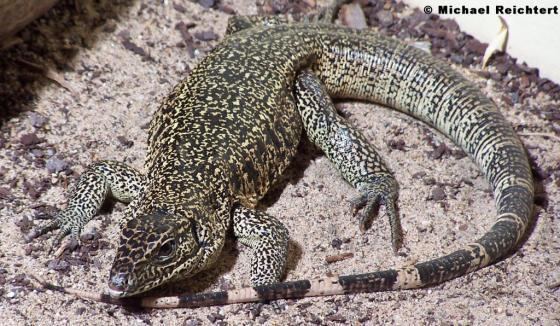 | ||
Lower classifications Gold tegu, Tupinambis rufescens | ||
Tupinambis is a lizard genus which belongs to the family Teiidae, and contains seven described species. These large lizards are commonly referred to as tegus (teiús in Portuguese); T. merianae (Argentine black and white tegu), T. rufescens (red tegu), and T. teguixin (gold tegu) are popular in the pet trade. They are primarily found in South America, although T. teguixin also occurs in Panama. Tegus that have escaped or have been illegally released have adapted and are increasing in several Florida counties including rural and suburban (especially south Miami-Dade and Hillsborough) counties, agricultural areas (especially Homestead and unincorporated Miami-Dade County, Florida) and publicly owned conservation areas (especially Southern Glades Environmental and Wildlife Area and southeast margin of Everglades National Park) of South Florida See invasive species website (www.IVE-GOT-1.org) for details with specific locations of credible observations and voucher specimens.
Contents
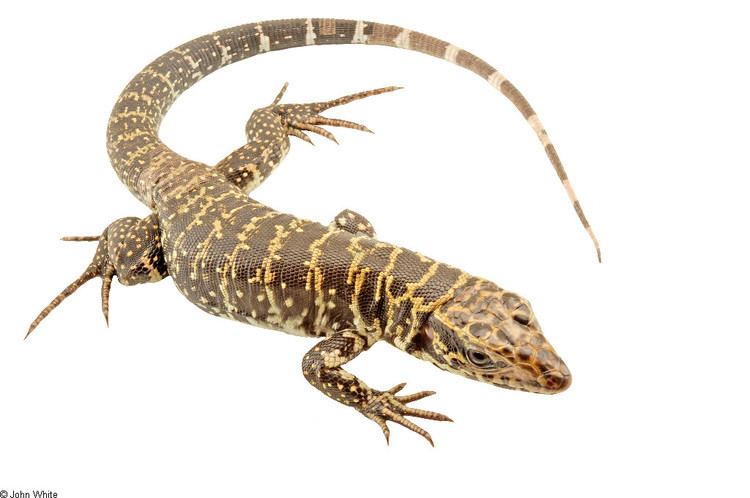
In 2012 a number of tegu species were reclassified from Tupinambis to the previously used genus Salvator. The newly proposed classification comes from a restructuring of the Teiidae family based upon the study of 137 morphological characteristics. The new classification is as follows: Salvator duseni (yellow tegu), Salvator rufescens (red tegu), Salvator merianae (black and white tegu), Tupinambis teguixin (gold tegu), Tupinambis longilineus (Rhondonia tegu), Tupinambis palustris (swamp tegu), Tupinambis quadrilineatus (four-lined tegu).
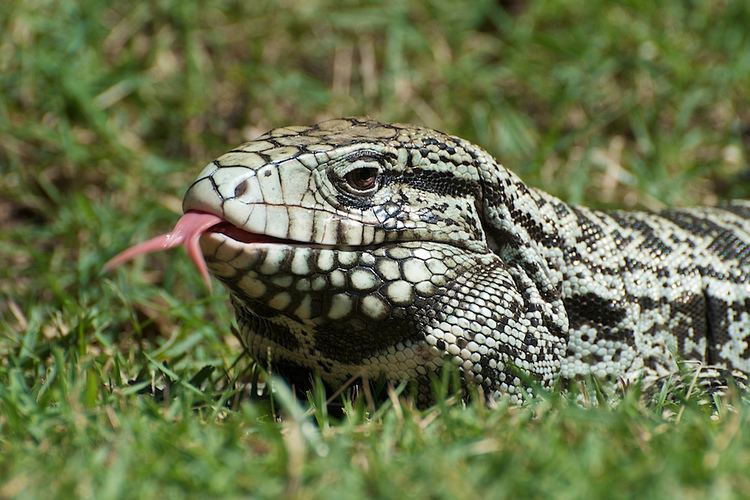
Description
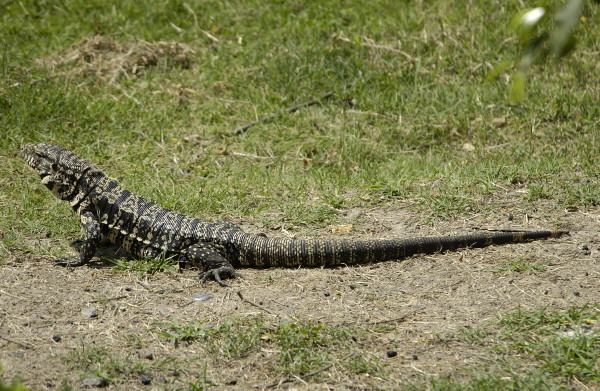
Tegus are large reptiles, with some species reaching a total length of around 1.23 m (4.0 ft), and a weight of approximately 6.8 kg (15 lb). These opportunistic, wide-ranging lizards can be found in a variety of habitats, from swamps to rainforests to savannahs and cities. Although terrestrial, they are capable swimmers, able to remain submerged for up to 22 minutes and having even been caught in gill nets set at sea. Tupinambis have heterodont dentition consisting of four different types of teeth. Incisor-type—tricuspid—teeth reside at the tip of the mouth. Recurved canine-type teeth occur further back on the tooth row. Behind those reside a separate set of incisor-like teeth (though flattened in a perpendicular plane to the first set of incisors). The rearmost teeth are blunt, rounded, peg-shaped teeth. The rearmost two tooth classes only occur in sexually mature individuals thus indicating an ontogenetic shift in tooth morphology. Along with changes in tooth type, the frequency of each tooth type also changes with ontogeny, without an overall changes in tooth count (approximately 70 teeth). Rather than increase tooth count, the teeth themselves increase in size as the jaw grows from hatchling to adult. This ontogenetic shift in tooth morphology suggests a shift in diet with age, however few dietary studies have been done to support this claim and limited stomach content observations do not show much variability between hatchlings and juveniles. Biomechanical studies have shown that Tegus have stronger limb bones than comparably-sized mammals or birds, a trait that may be inherent to amphibians and reptiles. They exhibit social and maternal behaviour; female Tegus construct burrows to lay their eggs in, and will protect their brood until they hatch. Up to 35 eggs are produced in a clutch. Tegus will hibernate together in groups, though males exhibit territorial behavior towards each other. Tegus exhibit sexual dimorphism. Males display greatly expanded and prominent "jowls" along the base of the lower jaw. These jowls are the result of extensive growth of the ventral pterygoideus muscles (a prominent jaw closing muscle in reptiles). Though both sexes exhibit hypertrophy of the ventral pterygoideus muscle, likely in response to their durophagous habits, male Tupinambis show both greater relative and absolute muscle mass compared to females. Further evidence for sexual selection of these jowls comes from observations that ventral pterygoideus muscle mass increases in males during the reproductive season. Metabolic changes also occur during the reproductive season, in which the body temperature is increased up to 10 degrees and sustained internally like a bird or a mammal. This discovery has major evolutionary implications, providing support for the hypothesis that endothermy may have evolved in response to parental care.
Ecology

Tegus are omnivorous, foraging for a wide range of foods using their forked tongues, including fruit, fungi, various arthropods, small vertebrates, carrion, and eggs. The amount of meat that is consumed by tegus decreases as the animals mature. As adults, tegus have few predators. Among them are big cats, birds of prey and large snakes. Tegus defend themselves using their powerful jaws, which can exert forces of up to 1000N. A bite from an adult tegu can crush human fingers.
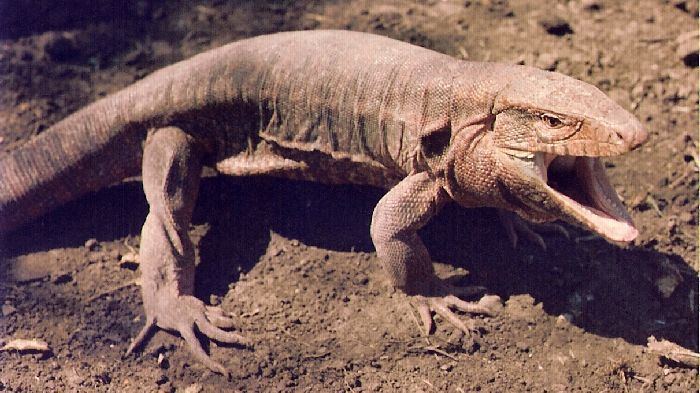
Though more terrestrial (morphologically less well-adapted for climbing into tree canopies or for swimming) tegus fill a similar ecological niche in South America to that filled by monitor lizards in Africa, Asia and Australia, and are an example of convergent evolution. Though similar in appearance to monitors, tegus are not closely related and can be distinguished by their larger heads, shorter necks, heavier bodies and different arrangement of the scales on the body and tail. Monitors have laterally compressed tails, well-suited for aquatic propulsion, while tegus' tails are more cylindrical or even broader than high. In addition, tegus can run on their hind legs like a Collared Lizard, while monitors are quadrupedal.
Economic importance and environmental impact
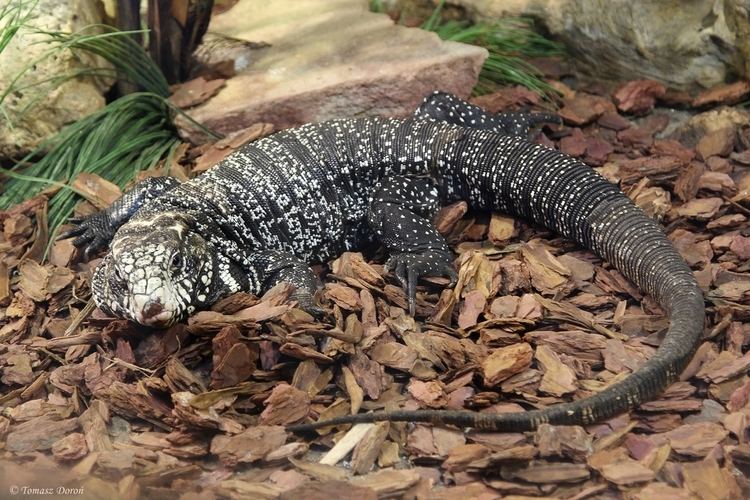
Tegus are among the most commercially exploited reptiles in the world. Up to 1,000,000 are harvested annually in their native Argentina for their hide and meat, and are particularly important as a source of income in rural or indigenous communities. Tegus can be also be found in captivity, where they are bred for the pet trade. They are reported to be highly intelligent, becoming docile as they mature and in some cases even ignoring food in favor of social interaction. However, tegus have demanding husbandry requirements due to their large size.
Within their native range, tegus are often thought of as pests, sometimes raiding chicken coops to feed on the eggs or fowl. They are noted predators of ground nesting bird and crocodilian eggs, and in some areas 80% of Spectacled Caiman nests are destroyed by tegus. In South Florida, they have become an invasive species, and prey on the eggs of American Alligators instead. Predation by feral tegus may pose a threat to Florida's endangered wildlife, such as the Key Largo woodrat and the American Crocodile. On account of their fruit eating habits, tegus may serve an important ecological function by dispersing seeds through their droppings.
Taxonomy and evolution
Species listed alphabetically by specific name.
Mitochondrial DNA analysis indicates a deep divergence between a northern clade (containing T. teguixin, T. longilineus, T. palustris and T. quadrilineatus) and a southern clade (containing T. merianae, T. rufescens and T. duseni.). The northern and southern clades are morphologically distinct, with the northern clade possessing a single pair of loreal scales between the eye and the nostril and a smooth texture to the scales on the body, and the southern clade possessing two pairs of loreal scales and a bumpy texture to the scales on the body. At least one recent review of the morphology of the Teiidae family has placed the tegus of the southern clade in the genus Salvator. Subsequent studies support the paraphyletic status of Tupinambis, though further research will be necessary to determine if the split will gain wider acceptance among the herpetological community. Comparative analysis of hemipenial anatomy also provides support for the split between Tupinambis and Salvator. Tegus probably originated sometime during the Cenozoic era. Tupinambis fossils from Argentina date back to the late-Miocene period. Fossils of the extinct tegu Paradracaena can be found in earlier Miocene deposits.
Name
As with many other animals from tropical South America (e.g. the Cariamae), the Tupinambis owes its scientific name to the pioneering accounts given by Piso & Marcgrave in their Historia Naturalis Brasiliae (1648). There was, however, a misinterpretation (by Linnaeus) of the Latin text, which reads "TEIVGVACV [...] Tupinambis", 'to the Tupinambá [Indians] TEIVGVACU'. Tupinambis was merely a metalinguistic term meaning 'to/for the Tupinambá,' whereas the intended, indigenous name for the animal was teiú-guaçú [lizard-big], lit. 'big lizard'.
